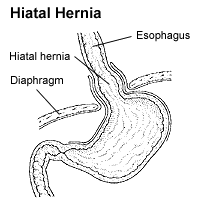Você sabia?
Você pode clicar duas vezes em uma palavra para procurá-la na TermGallery.
Você pode clicar duas vezes em uma palavra para procurá-la na TermGallery.
Significados de hiatal hernia em inglês
português
hérnia de hiato 
Hernia resulting from the protrusion of part of the stomach through the diaphragm.
Sinônimos
Examples for "hiatus hernia"
Examples for "hiatus hernia"
1
Objective: Recurrent hiatus hernia is frequently found in patients undergoing reoperative antireflux surgery.
2
Paraesophageal hiatus hernia is a very rare entity in children.
3
Conventional Remedy: From your description it sounds like the symptoms of a hiatus hernia.
4
A LES-CD ≥ 3 cm seems to discern a hiatus hernia of clinical significance.
5
The clinical course of a massive paraesophageal hiatus hernia containing colon and stomach in a five-year-old boy is presented.
1
Alderson reports a fatal case of diaphragmatic hernia with symptoms of pneumothorax.
2
In all six cases of diaphragmatic hernia MRI provided additional information.
3
The highest rate of mortality was observed for congenital diaphragmatic hernia.
4
Congenital diaphragmatic hernia is a rare congenital malformation, as well as kidney ectopia.
5
Abbey Murphy Weir was diagnosed with a diaphragmatic hernia when she was three-years-old.
Uso de hiatal hernia em inglês
1
An endoscopy was done demonstrating a hiatal hernia, and five benign polyps.
2
Its relief rate and adverse rate were influenced by hiatal hernia and drinking.
3
Gastric acid secretion was assessed by endoscopic gastrin test, and the presence of hiatal hernia by endoscopy.
4
A Nissen sleeve was performed due to its GERD, hiatal hernia and multiple polyps on the stomach.
5
Since he had a large sliding esophageal hiatal hernia that was increasing in size, he underwent laparoscopic fundoplication.
6
Background: Current literature is characterized by a discrepancy between reported symptomatic and radiological recurrent hiatal hernia's following primary repair.
7
The most common type is an axial hiatal hernia with incidence of 94.58%.
8
The size of a hiatal hernia was typically reported in a subjective fashion and only infrequently was the type specified.
9
Six occult umbilical hernias, 1 inguinal hernia, and 1 hiatal hernia were noted on endoscopic exploration.
10
Conclusions: Increased acid secretion after H. pylori eradication is an important risk factor of reflux oesophagitis, especially in patients with hiatal hernia.
11
After excluding patients undergoing concomitant hiatal hernia repair or fundoplication, there were 22,870 patients with 6-month follow-up.
12
Three patients with a giant hiatal hernia were treated by a simultaneous thoraco-laparoscopic approach, which proved to be technically feasible and safe.
13
Age, body mass index, size of the initial hiatal hernia, and sex had no significant effect on whether a patient developed a recurrence.
14
The aim of this trial is to analyze 1-year outcome of laparoscopic hiatal hernia repair using sutures versus sutures reinforced with non-absorbable mesh.
15
Conclusion: N-sleeve is a feasible and safe alternative in obese patients with reflux and hiatal hernia when Roux-en-Y gastric bypass it is not indicated.
16
Hiatal hernia is a frequent finding during upper gastrointestinal endoscopy.

